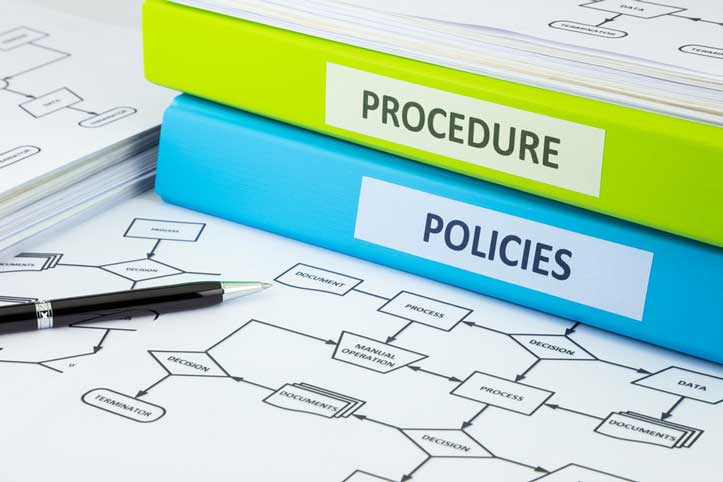As small companies start to grow, they need formal HR policies and procedures to effectively manage their human capital. Whether you’re writing HR policies and procedures from scratch or updating your existing documentation, it’s important to follow certain guidelines to ensure company-wide adoption and minimize employee resistance.
HR policies and procedures seem straight forward to develop, but there are a lot of pitfalls that HR professionals must pay attention to. When done incorrectly, HR policies and procedures can turn into a nightmare and hurt the business as opposed to helping it.
To ensure that your efforts yield excellent results, make sure that your HR policies and procedures follow the below best practices:
Adapt Your Policies to the Business
One of the biggest mistakes HR professionals make is to try and force policies and procedures onto a business without carefully studying its core needs. This happens frequently with HR professionals and consultants that have pre-defined templates and want to cut corners by lessening the workload and hassle of designing customized manuals.
Not only is this lazy, but it’s also counterintuitive and dangerous. HR policies and procedures are supposed to help a business, not put an administrative strain on its operations. Therefore, the first thing you need to do is to study the entire company’s workflows, processes, and informal policies and procedures to understand how everything works. Only then can you proceed with designing customized policies and procedures that fit your company’s exact needs.
Break Down Policies into their Counterparts
Policies and procedures manuals can get quite large in volume (hundreds of pages!) and therefore become challenging to refer to down the line once implementation occurs.
A strategy that I always follow is to break down each functional policy or procedure into its individual counterparts. For example, instead of creating a Travel and Accommodation Allowances policy and listing everything under that title, I can break it down as such:
Travel and Accommodation Allowances
- Purpose and Scope
- Travel Expenditures
- Transportation
- Accommodation
- Meals
- Business Entertainment
- Conferences and Events
- Other Reimbursable Expenses
- Non-Reimbursable Expenses
- Employee Responsibilities
- Reimbursement Process
- Expense Report Form
Each sub-policy is a separate section, with a separate entry in the table of contents. Doing so allows you to keep track of every single sub-policy and referring back to the manual for guidance becomes much easier since you know exactly where to look for answers.
Assign Reference Codes to Everything
I always give each policy, sub-policy, procedure, and form its unique reference number. This is invaluable for auditing, especially if your company already has or is applying for an ISO 9001 or Six Sigma certification.
It’s recommended that you audit your policies and procedures every 2 – 3 years to ensure that they’re current and valid. Therefore, they’re going to change with time.
Start your policy numbering from 001 or 0001 and move forward from there. Feel free to add a prefix to your numbering, such as HR-001.
Create a version number for your entire HR policies and procedures manual. This will allow you to track version changes in your manual. Start off with version 1.0 and whenever you make minor changes, increase the number to the right of the decimal point by a single unit, such as 1.1 or 1.2. When you make a major change, such as adding completely new policies or redesigning a procedure from scratch, then increase the number to the left of the decimal point by a single unit and reset the number to the right of the decimal point to zero. So if your previous version was 1.4, it becomes 2.0 after a major change.
Include Process Maps with Your Procedures
For procedures that are used frequently, such as your recruitment or leave request procedures, it’s a good idea to design a visual process map using software tools such as Microsoft Visio or Lucidchart.
Employees are not going to read a long list of procedures every time they need to do something. Especially at first, such a hassle might lead to resistance and employees could stick to the old ways of doing things.
By having visual diagrams of how each process works, referring to them for guidance becomes quick and simple.
Seek Acknowledgement from Managers and Employees
Before implementing your newly designed HR policies and procedures, it’s important to get the feedback of line managers and top management. While doing so, make sure to present the business case and value of each policy and procedure that you’ve designed. Giving a presentation to management is a great way to highlight all the key ideas and your reasoning behind these recommendations.
Once you have approval from top management and the blessing of line managers, the next step is to design an Employee Handbook that includes all the HR policies and procedures that are relevant to employees. I also recommend designing an Employee Acknowledgement Form that all employees should sign once they’ve read the employee handbook. This enforces accountability and eliminates excuses such as “I wasn’t aware of that new policy” from employees. Finally, include an approvals area in each section of your HR policies and procedures manual for documentation purposes.





